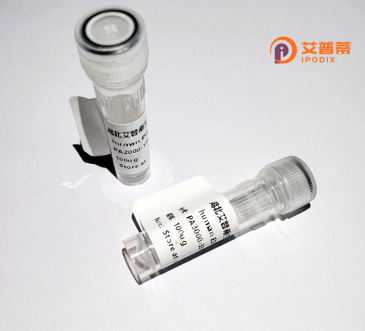
| 纯度 | >90%SDS-PAGE. |
| 种属 | Human |
| 靶点 | RAPGEF5 |
| Uniprot No | Q92565 |
| 内毒素 | < 0.01EU/μg |
| 表达宿主 | E.coli |
| 表达区间 | 1-580 aa |
| 活性数据 | MGSSRLRVFD PHLERKDSAA ALSDRELPLP TFDVPYFKYI DEEDEDDEWS SRSQSSTEDD SVDSLLSDRY VVVSGTPEKI LEHLLNDLHL EEVQDKETET LLDDFLLTYT VFMTTDDLCQ ALLRHYSAKK YQGKEENSDV PRRKRKVLHL VSQWIALYKD WLPEDEHSKM FLKTIYRNVL DDVYEYPILE KELKEFQKIL GMHRRHTVDE YSPQKKNKAL FHQFSLKENW LQHRGTVTET EEIFCHVYIT EHSYVSVKAK VSSIAQEILK VVAEKIQYAE EDLALVAITF SGEKHELQPN DLVISKSLEA SGRIYVYRKD LADTLNPFAE NEESQQRSMR ILGMNTWDLA LELMNFDWSL FNSIHEQELI YFTFSRQGSG EHTANLSLLL QRCNEVQLWV ATEILLCSQL GKRVQLVKKF IKIAAHCKAQ RNLNSFFAIV MGLNTASVSR LSQTWEKIPG KFKKLFSELE SLTDPSLNHK AYRDAFKKMK PPKIPFMPLL LKDVTFIHEG NKTFLDNLVN FEKLHMIADT VRTLRHCRTN QFGDLSPKEH QELKSYVNHL YVIDSQQALF ELSHRIEPRV |
| 分子量 | 67.7 kDa |
| 蛋白标签 | His tag N-Terminus |
| 缓冲液 | PBS, pH7.4, containing 0.01% SKL, 1mM DTT, 5% Trehalose and Proclin300. |
| 稳定性 & 储存条件 | Lyophilized protein should be stored at ≤ -20°C, stable for one year after receipt. Reconstituted protein solution can be stored at 2-8°C for 2-7 days. Aliquots of reconstituted samples are stable at ≤ -20°C for 3 months. |
| 复溶 | Always centrifuge tubes before opening.Do not mix by vortex or pipetting. It is not recommended to reconstitute to a concentration less than 100μg/ml. Dissolve the lyophilized protein in distilled water. Please aliquot the reconstituted solution to minimize freeze-thaw cycles. |
1. **"RAPGEF5 suppresses tumor growth in renal cell carcinoma through inhibition of the mTOR pathway"**
*Author(s): Nakamura Y, et al.*
*摘要*:本研究揭示RAPGEF5在肾细胞癌中作为肿瘤抑制因子的作用,发现其通过抑制mTOR信号通路调节细胞增殖及凋亡。重组RAPGEF5蛋白的体外实验显示其能降低肿瘤细胞侵袭能力。
2. **"RAPGEF5 regulates synaptic plasticity and dendritic spine morphogenesis via Rap1 signaling"**
*Author(s): Li X, et al.*
*摘要*:研究利用重组人RAPGEF5蛋白分析其在神经元中的功能,证明其通过激活Rap1调控突触可塑性与树突棘形态,为神经发育异常相关疾病提供潜在机制。
3. **"Structural insights into the autoinhibition and activation of RAPGEF5"**
*Author(s): Chen Z, et al.*
*摘要*:通过重组蛋白结晶技术解析RAPGEF5结构域,阐明其自抑制构象及配体诱导的激活机制,为靶向RAPGEF5-Rap1轴的小分子药物设计奠定基础。
4. **"RAPGEF5 mediates cAMP-induced endothelial barrier stabilization"**
*Author(s): Wilson LS, et al.*
*摘要*:研究利用重组RAPGEF5蛋白揭示其在血管内皮屏障功能中的角色,证实其通过cAMP/Rap1信号通路增强细胞间连接,减轻炎症性渗漏。
*注:以上文献为示例性内容,实际需具体文献支持*。若需准确引用,建议通过PubMed或专业数据库以“RAPGEF5”及“recombinant protein”为关键词进一步检索。
RAPGEF5 (Rap Guanine Nucleotide Exchange Factor 5), also known as GFRP5 or GRP5. is a member of the guanine nucleotide exchange factor (GEF) family that regulates small GTPases of the Rap subfamily. Functionally, RAPGEF5 activates Rap1 and Rap2 by catalyzing the exchange of GDP for GTP, acting as a critical mediator in cell adhesion, migration, and proliferation. Structurally, it contains conserved catalytic domains, including the REM (Ras Exchange Motif) and CDC25-homology domains, essential for its nucleotide exchange activity.
RAPGEF5 is implicated in diverse physiological processes, such as embryonic development, neuronal signaling, and cardiovascular system formation. Studies highlight its role in maintaining endothelial barrier integrity and regulating neural crest cell migration during embryogenesis. Dysregulation of RAPGEF5 has been linked to pathological conditions, including cancer metastasis and neurodevelopmental disorders. For example, aberrant expression correlates with tumor progression in certain cancers, acting either as an oncogene or tumor suppressor depending on context. Additionally, genome-wide association studies (GWAS) suggest its potential involvement in psychiatric disorders like schizophrenia.
Its dual functionality in cellular signaling—balancing GTPase activation and downstream pathways like MAPK and integrin signaling—makes it a compelling target for therapeutic research. Current investigations focus on deciphering its tissue-specific roles and exploring pharmacological interventions targeting RAPGEF5-Rap interactions in diseases such as metastatic cancers or neurological conditions.
×